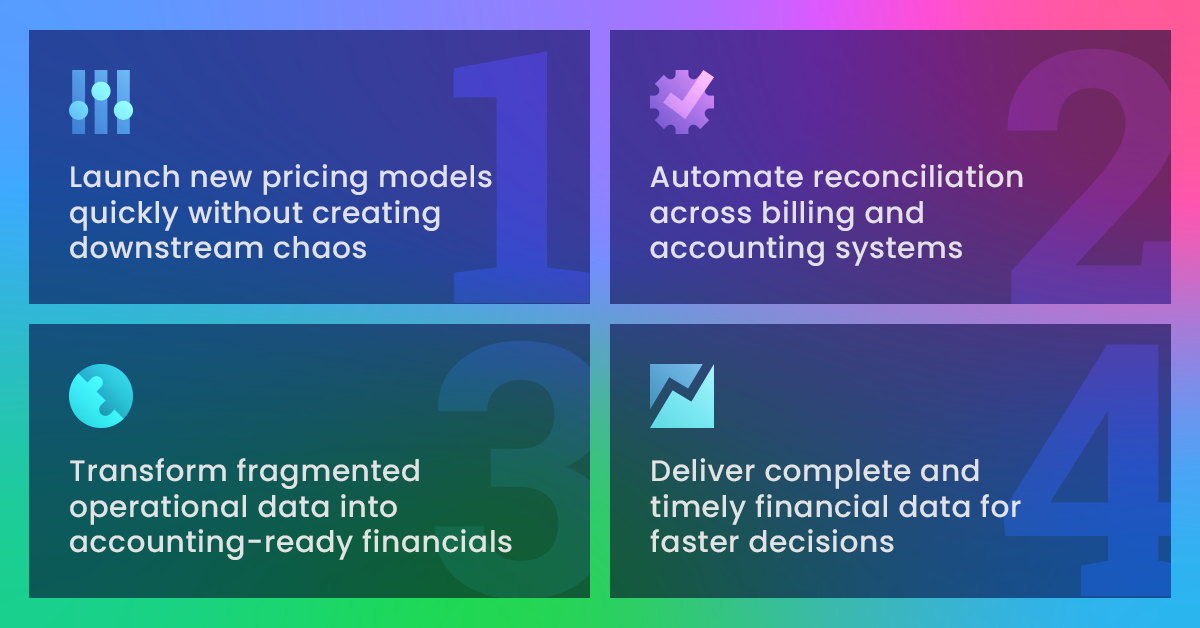Scaling usage-based billing without breaking finance: Key Lessons from Leapfin + Metronome
Usage-based and hybrid pricing models are scaling fast. Customers love the flexibility, product teams love the experimentation, and GTM loves the upside. Finance, however, is often left with the fallout: fragmented data, constantly changing revenue rules, and spreadsheets pushed far beyond their limit.
Every pricing shift creates downstream accounting consequences. What used to be a single, predictable subscription schedule can quickly become millions of usage events that must be traced, reconciled, and recognized accurately.
This is why Leapfin and Metronome have partnered – to support Finance teams with the automation, accuracy, and real-time visibility required to scale usage-based monetization.
Below are the four major lessons shared in our recent joint webinar:
- Automation and AI are helping Finance teams launch new pricing models quickly while minimizing downstream chaos
- Today's fastest Finance teams automate reconciliation across billing and accounting systems
- The importance of transforming fragmented usage data into accounting-ready financials
- Automation and AI make it easier for finance to deliver complete and timely financial data for faster business decisions
1. How automation and AI are helping Finance teams launch new pricing models quickly without creating downstream chaos
Finance has always been expected to maintain accuracy and control. But usage-based billing adds a new expectation: adaptability.
When pricing models change monthly or even weekly, downstream systems must adjust just as fast.
Where things break without automation:
- New usage events require new revenue rules
- Hybrid tiers introduce edge cases
- Promotions, credits, and discounts multiply scenarios
- Manual spreadsheets get brittle and slow down close
Metronome gives product and billing teams the flexibility to experiment with pricing. Leapfin ensures those changes do not break revenue schedules, delay financial reporting, or require finance to rebuild logic from scratch.
Outcome: Faster pricing changes without downstream accounting damage.
2. Want to move faster? Automate reconciliation across billing and accounting systems
Usage models generate high-volume, high-frequency data. Reconciliation becomes impossible to manage manually when billing, payments, and usage data all live in separate places.
Leapfin and Metronome eliminate that fragmentation by integrating data streams and automating reconciliation from event to journal entry.
Outcome: A faster close, fewer reconciliation bottlenecks, and cleaner audit evidence.
3. The importance of transforming fragmented operational data into accounting-ready financials
Usage-based billing is as much a data challenge as it is an accounting challenge. When product telemetry, billing events, credits, payments, and contract data all speak different “languages,” finance becomes a data janitor instead of a strategic operator.
Leapfin standardizes usage data at the event level, applies ASC 606 rules at scale, and generates clean, auditable accounting outputs across the ERP, BI, and data warehouse.
Outcome: A reliable revenue command center that eliminates guesswork and rework.
4. Automation and AI make it easier for finance to deliver complete and timely financial data for faster decisions
Companies using a usage-based model gain a competitive edge when they can run the business on daily revenue insights, not last-month results. This pushes finance closer to a zero-day close model – where revenue is always up to date and trusted.
Daily revenue becomes a true operating metric, enabling scenario forecasting, margin visibility, and faster GTM alignment.
Outcome: Finance shifts from reactive reporting to proactive decision-making.
Audience Q&A from the live webinar
Q: How can finance get earlier visibility into pricing changes?
Ray Lau, Leapfin :
“Pricing committees rarely move fast enough to be effective. Someone needs clear ownership of pricing – often a Chief Value Officer mindset – and finance must have a voice in that loop. Treat monetization like a product, not a side meeting, and alignment comes much earlier.”
David Hoang, Metronome :
“I agree. The most successful companies treat monetization as a product function with shared success metrics. When finance is aligned with product on outcomes, visibility and influence happen much earlier in the process.”
Q: Where should Finance teams start if they are still reconciling usage data in spreadsheets?
Ray:
“Centralize the revenue data. You cannot keep revenue metrics and GAAP reporting in separate systems and expect alignment. Solve for the revenue data source of truth first.”
Q: How realistic is automation for teams without engineering support?
David:
“Very realistic. Tools like Metronome allow finance to configure pricing changes without engineering, and get clean invoice data downstream.”
Ray:
“Same for Leapfin. Our workflows let finance set up and maintain rev rec logic in natural language. The goal is to remove engineering as a dependency for accounting accuracy.”
Final takeaway
Finance should not have to choose between innovation and accuracy. With Leapfin and Metronome, teams can support pricing agility, automate reconciliation, gain real-time revenue clarity, and operate with confidence.
👉 Watch the webinar replay
👉 Learn more about the Leapfin + Metronome partnership
👉 Book a demo to see how Leapfin automates usage-based rev rec and reconciliation
See how Leapfin works
Get a feel for the ease and power of Leapfin with our interactive demo.

